The classic Mexican pozole is a rich stew made with hominy, pork butt, a chile sauce made with dried chiles and flavored broths. While it is a simple dish, preparing the dried chile rojo sauce can sometimes deter people from making it. This slow cooker recipe uses a smoky ancho/pasilla powder to season the broth for easy cooking, and substitutes navy beans for hominy to keep it slow carb compliant.
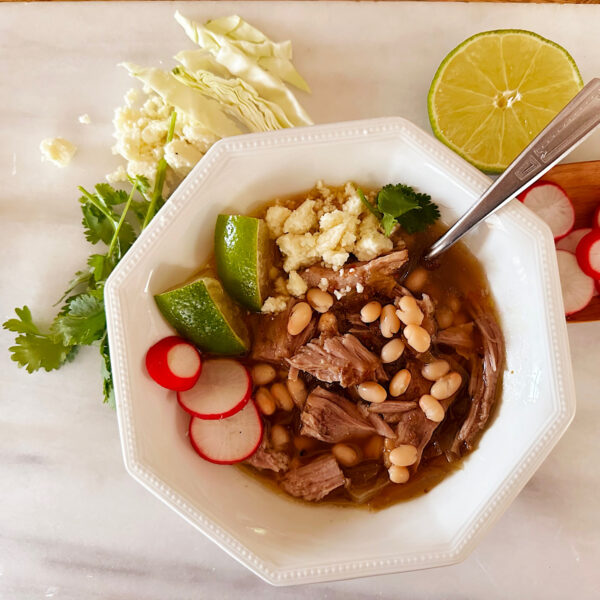
Jump to: RECIPE | Brief History of Pozole | Recipe Ingredients | Dried Anchos vs Ancho Powder | Navy beans as hominy substitute | Recommended Pozole garnishes
This post may contain affiliate links, and you can read our disclosure information here–
Is it Posole or Pozole?
The word posole derives from pozolli, the Nahuan word for hominy. And not surprisingly – when prepared traditionally – hominy is one of the major components of this popular Latin stew.
Nahuan is an ancient Aztecan language, giving you a major clue as to the origins of this dish – Mesoamerica. If you research this dish, you will see it referred to as both posole and pozole.
Both spellings are considered correct, with posole being the older version. Whether you spell it with an ‘s’ or a ‘z’, this dish is a well-loved comfort food across Mexico and Central America.
Festive Fare or Everyday Meal?
Just like your family has a classic recipe for their favorite stew, every Mexican household has their family’s prized version of pozole. And make no mistake, this dish is beloved by all.
While popular in home kitchens, you can also find pozole on the menu of most Mexican restaurants throughout Latin America. Some elevate it with their own little twist and others serve it as a straightforward home-cooked meal.
Traditionally this dish is served for celebrations. You will find it on the table at Christmas, New Year’s, Mexican Independence Day, or any occasion reserved for merrymaking.
In some regions of Mexico it is traditional to serve this ultimate comfort food every Thursday or Saturday. It is so delicious people crave eating it weekly. You might be surprised and find it becomes a regular menu item in your house too!
If you don’t really care about the carb level of hominy, try this more traditional pork pozole rojo recipe.
Or try this alternative version of a slow carb pozole that uses garbanzo beans in place of hominy and sears the pork ahead of time.
Ingredient List:
The following photo shows you all the ingredients you will need for this recipe. For details on measurements, see the recipe below.
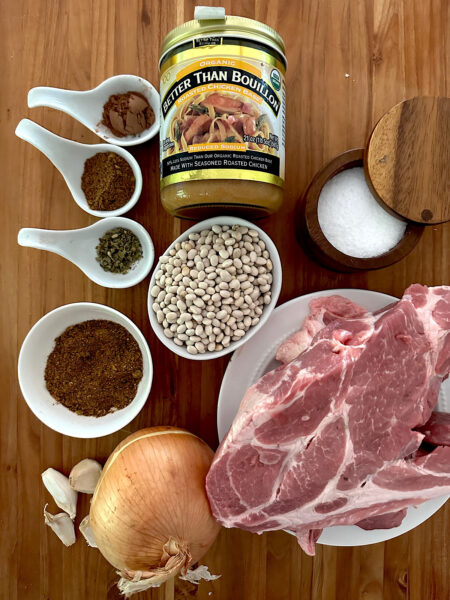
Dried Ancho Chiles vs Ancho Powder
Dried ancho peppers are frequently used by Mexican cooks in making posole. Dried ancho peppers are found in most Mexican and Latin grocery stores.
Since they can’t be used straight from the package however, you must first reconstitute them by soaking them. Once they have become pliant, you need to carefully clean and seed them. Both of these steps can be time consuming and are a bit of a pain when you want to get straight to cooking.

If you want to save time and still keep the wonderful flavor profile of the ancho peppers, ground ancho chile is the key. Just be sure to get “fresh” ancho powder from a reputable spice vendor.
Sometimes dried spices have been languishing on the grocery store shelf or the warehouse for so long that the distinctive spice has lost its punch.
You can usually find ground ancho chile at Mexican or Latin grocery stores. The turnover of ingredients you buy there will be more frequent and you might be surprised to find other wonderful ingredients with which to experiment.
If you like your pozole with more heat, try substituting powdered chipotle for the ancho spice powder. The smoky flavor you’d get with ancho powder still comes through, but you’ll be pleasantly surprised with the extra kick.
Or, if you don’t want the smoky flavor just go with you favorite chile pepper powder.

TIP: All your dishes will taste best if your spices are fresh. It may be tempting to purchase a large quantity of a particular spice because it is cheaper per ounce, but if you can’t use that quantity up in approximately one year the spice will begin to lose its potency.
Customizing Pozole with Garnishes
One of the best parts of this dish for many is the variety of side garnishes that are laid out on the table for people to customize their preferred flavor enhancements.
Depending on the occasion where you are serving posole, you can make the layout of the garnishes as fancy or simple as you choose. You could put your accompaniments on a Lazy Susan and let people spin to their favorite toppings.
Chips are usually included on the table, but of course these are not low carb, slow carb or keto. A few of the more traditional garnishes which “are” low carb include:
- Thinly sliced red radish
- Shredded cabbage
- Cilantro
- Diced avocado
- Queso Fresco
- Lime slices/lime juice
- Chile de arbol peppers for more heat
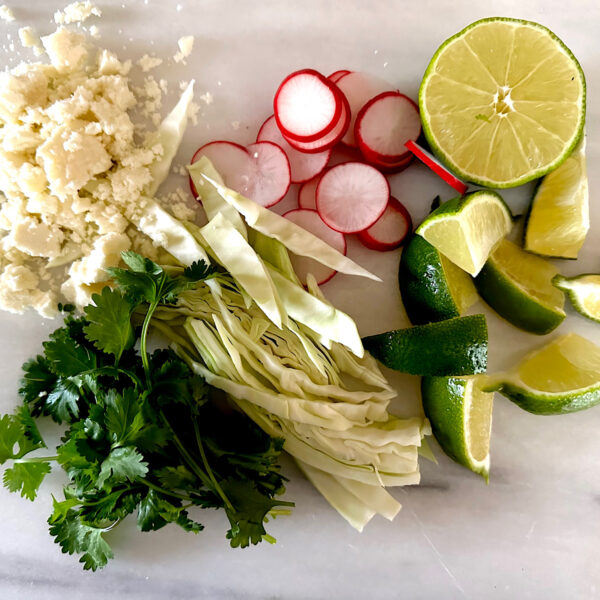
How to Store or Freeze Pozole
This recipe for slow carb pork pozole makes a large batch. It’s great for sharing with family or friends, but it is also perfect for the type of batch cooking that gets you several meals over the course of a week.
Refrigerated, the leftovers will keep for approximately one week. Or better yet, freeze the leftovers so you have a delicious meal ready for an evening when you don’t feel like cooking.
Place the prepared pozole in freezer bags, remove as much air as possible to prevent freezer burn and seal. Mark your container with the date you put the leftovers in the freezer and they will keep fresh for up to three months.
To serve, thaw overnight in the fridge, and warm over low heat on the stovetop. Voila, dinner is served!
TIP: All spices should be stored in a cool, dry, dark environment. But did you know that for maximum freshness red spices, such as chile powders, should be stored in the refrigerator? This is especially important if you live in a hot and humid locale.
Navy Beans and the Slow Carb Diet
Slow carb diets allow beans as a protein source that won’t derail weight loss. Substituting white beans or garbanzo beans for the hominy is therefore a modification that works for slow carb diets without losing the delicious flavor of posole.
Legumes and beans have a lot of fiber and protein and because of this they are considered a “slow carb” that can offer a form of energy that will not spike your insulin levels like a refined carb.
You don’t need beans with every meal however, in fact too many beans can stall your diet, as they are fairy dense in calories.
An in-depth study on longevity in regions across the world, known as the Blue Zones longevity study, found that the one diet component that all of the various cultures shared was beans.
This common thread among the Blue Zones, along with Tim Ferris’s slow carb diet recommends beans as a healthy way to get in recommended amounts of protein.
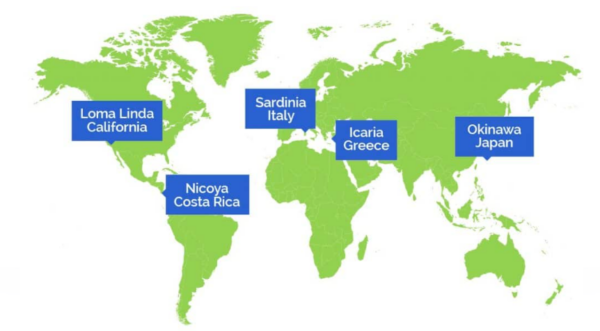
A keto diet, on the other hand, does not include beans.
If you want to make pozole and stay keto compliant, you could make pozole without hominy or beans (a pork and chile stew essentially) and garnish with a lot of cabbage and radish. It will change the texture of posole more so than beans, but it is still a tasty alternative.
A similar slow carb version of pozole using garbanzo beans rather than navy beans is this Seared Pork Pozole with Garbanzo Beans.

If you want to celebrate with pozole and are not following a slow carb diet this traditional version of pozole rojo is excellent.
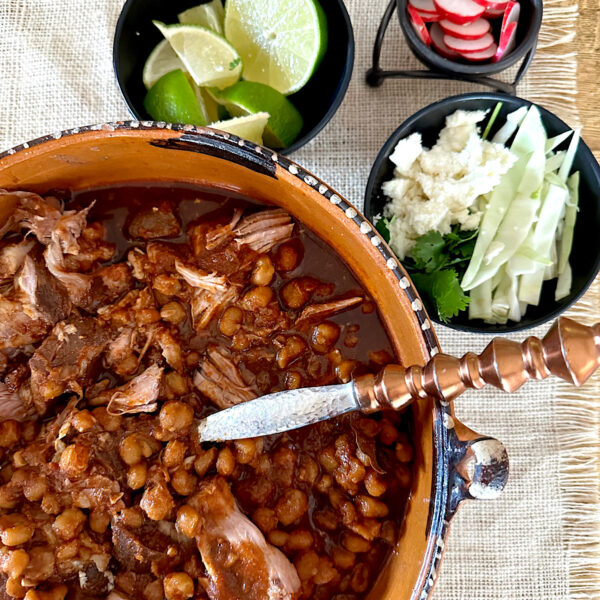
More Latin American Celebration Dishes
This Camarão (pumpkin with shrimps) is a centerpiece dish from Brazil that is full of incredible flavor and ever-so-beautiful
And herald in Summer with this popular Mexican street food of fruit and veggies sprinkled with Tajin
If you enjoy all types of Mexican food, check out this category of ALL Mexican recipes, where you will find over 40 Mexican recipes, from casual, to low carb, to fancy.
Slow Carb Pork Posole in the Crockpot
Equipment
Ingredients
- 1 tablespoon ground cumin toasted and then ground if possible
- 1 teaspoon oregano
- ¼ cup ground Ancho chile powder
- 1 teaspoon unsweetened cocoa powder optional
- 1 large onion chopped
- 4-6 garlic cloves minced
- 4 cups chicken broth
- 1 teaspoon salt
- 28 ounces canned white navy beans (or 2 cups of dried navy beans soaked overnight)
- 2 ½ – 3 pounds boneless pork shoulder aka Boston Butt, cut into small chunks (for more taste you can sear the chunks before adding to crock pot)
Instructions
- Whisk together the spices in a small bowl and add to the crockpot. Add the rest of the ingredients to the crockpot, excepting the pork.1 tablespoon ground cumin, 1 teaspoon oregano, 1/4 cup ground Ancho chile powder, 1 teaspoon unsweetened cocoa powder, 1 large onion, 4-6 garlic cloves, 4 cups chicken broth, 1 teaspoon salt, 28 ounces canned white navy beans
- Add the pork to the slow cooker/crockpot and submerge in the liquid stock. If the liquid does not cover, add a little more water or stock.**note: if you want enhanced flavor, cut the pork into chunks and sear in oil before adding to the crockpot.2 1/2 – 3 pounds boneless pork shoulder
- Cook on low 6 hours or until meat is tender. Taste, and add more salt and more chile powder if needed.1/4 cup ground Ancho chile powder
- Serve with Mexican garnishes such as sliced avocados, sliced radishes, chopped cilantro, chopped red onions or lime wedges1 tablespoon ground cumin
- This is even better the next day. Just turn the slow cooker back on low for a couple more hours. You really can’t overcook.

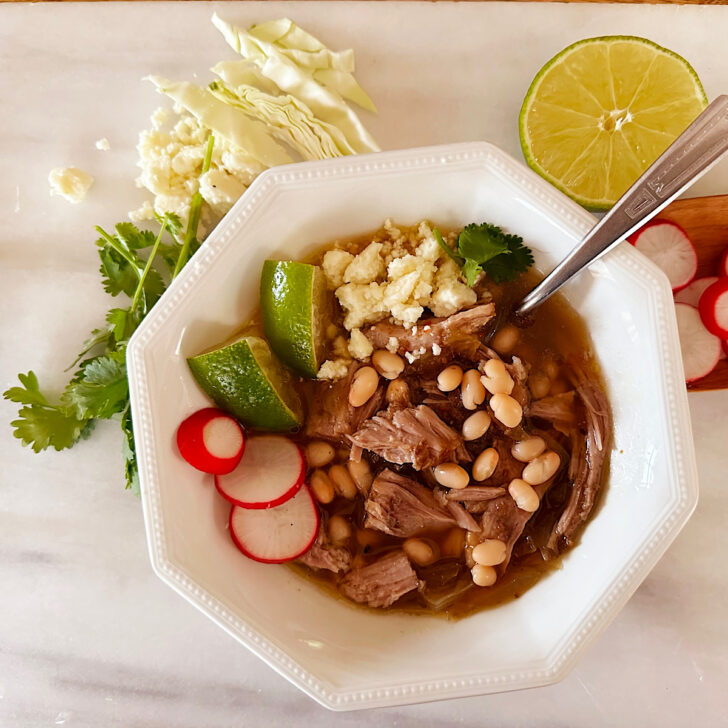
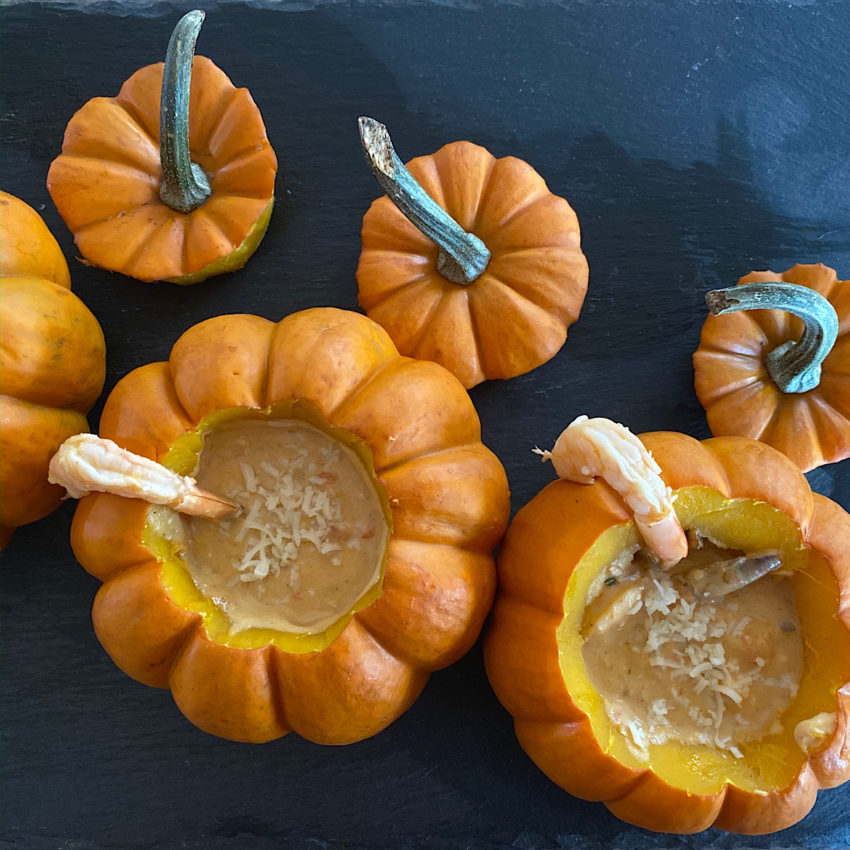
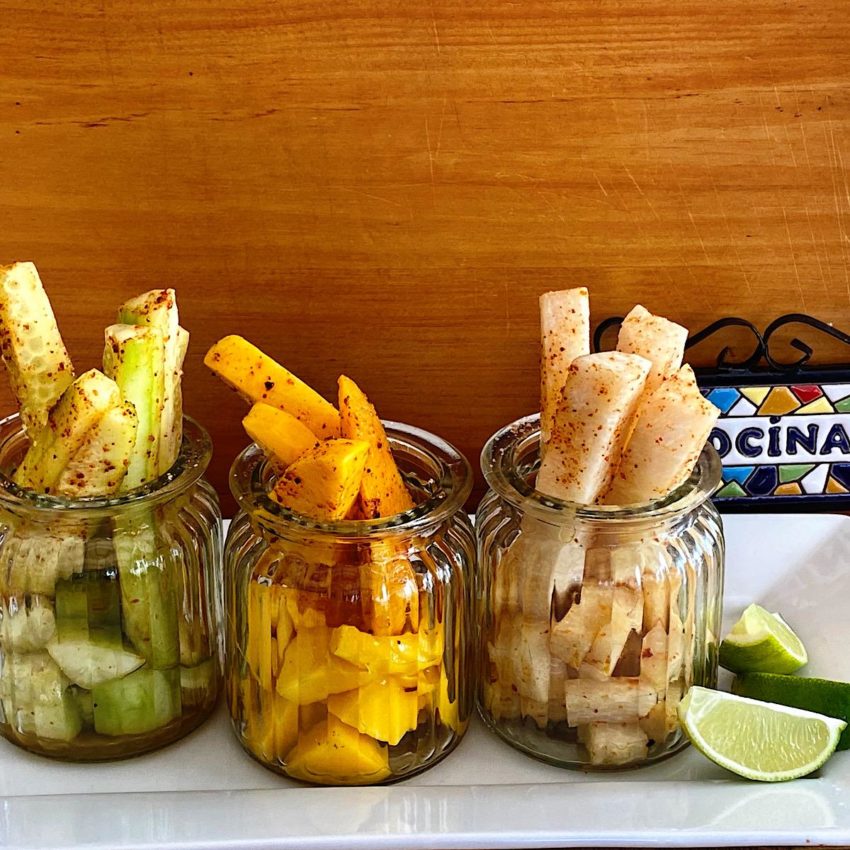
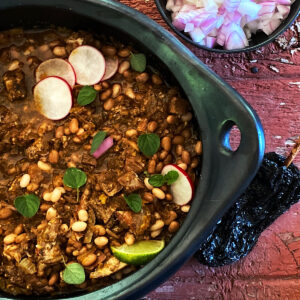
[…] Because Pozole/Posole is so popular, I have some variations on the recipe here. […]
How do you get only 11.4g carbs while including 28oz of white navy beans? Is that net carbs? What brand of beans are you using? Thank you!
@Stacey McCord, 28ozs divided by the amount of servings.
Hi Stacey, I’m not sure what your question or comment refers to. If it confusion over how many beans to use, it is 2 14-oz cans of canned beans (which equals 28 oz), OR 2 cups of dried beans. I went back into the recipe and tried to make it a bit clearer, as well as redoing the nutrition calculations (which were off as you noted).
Thanks for the heads up Stacey! That post was recently updated, so it is entirely possible that is a mistake. I’ll run the recipe ingredients through the nutrition analyzer again tonight and see what it says. The update might have missed something.